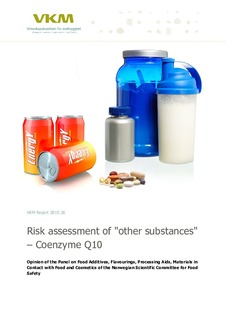| dc.contributor.author | Herlofson, Bente Brokstad | |
| dc.contributor.author | Mathisen, Gro Haarklou | |
| dc.contributor.author | Bruzell, Ellen Merete | |
| dc.contributor.author | Granum, Berit | |
| dc.contributor.author | Hetland, Ragna Bogen | |
| dc.contributor.author | Husøy, Trine | |
| dc.contributor.author | Rohloff, Jens | |
| dc.contributor.author | Wicklund, Trude | |
| dc.contributor.author | Steffensen, Inger-Lise | |
| dc.date.accessioned | 2017-10-20T06:22:08Z | |
| dc.date.available | 2017-10-20T06:22:08Z | |
| dc.date.created | 2017-10-19T12:32:40Z | |
| dc.date.issued | 2015 | |
| dc.identifier.isbn | 978-82-8259-181-2 | |
| dc.identifier.uri | http://hdl.handle.net/11250/2461129 | |
| dc.description.abstract | The Norwegian Scientific Committee for Food Safety (VKM) has, at the request of the Norwegian Food Safety Authority, assessed the risk of intake of 100 mg/day of coenzyme Q10 in food supplements. For the risk characterization, the values used for comparison with the estimated exposure are 900 mg/day (corresponding to 12.9 mg/kg bw per day in a 70 kg adult) based on human studies (4 weeks) and the NOAEL of 1200 mg/kg bw per day based on a long-term toxicity study in rats (52 weeks). No specific studies on children (10 to <14 years) and adolescents (14 to <18 years) were identified. Based on the included literature there was no evidence indicating that age affects tolerance for CoQ10. Therefore, a tolerance as for adults, based on body weight, was assumed for children and adolescents, in the comparison with human data.
VKM concludes that it is unlikely that a daily dose of 100 mg of CoQ10 from food supplements causes adverse health effects in children (10 to <14 years), adolescents (14 to <18 years) and adults (≥18 years). | nb_NO |
| dc.language.iso | eng | nb_NO |
| dc.publisher | Norwegian Scientific Committee for Food Safety (VKM) | nb_NO |
| dc.relation.ispartof | VKM Report | |
| dc.relation.ispartofseries | VKM Report; | |
| dc.relation.uri | https://vkm.no/download/18.645b840415d03a2fe8f26085/1502712503082/aedcc3905c.pdf | |
| dc.title | Risk assessment of "other substances" – Coenzyme Q10. Opinion of the Panel on Food Additives, Flavourings, Processing Aids, Materials in Contact with Food and Cosmetics of the Norwegian Scientific Committee for Food Safety | nb_NO |
| dc.type | Research report | nb_NO |
| dc.description.version | publishedVersion | nb_NO |
| dc.source.pagenumber | 44 | nb_NO |
| dc.source.issue | 2015:26 | nb_NO |
| dc.identifier.cristin | 1505911 | |
| cristin.unitcode | 194,66,10,0 | |
| cristin.unitname | Institutt for biologi | |
| cristin.ispublished | true | |
| cristin.fulltext | original | |
